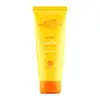What's inside
What's inside
 Key Ingredients
Key Ingredients

 Benefits
Benefits

 Concerns
Concerns

 Ingredients Side-by-side
Ingredients Side-by-side

Water
Skin ConditioningSodium Lauroyl Sarcosinate
CleansingPolyacrylate-33
Disodium Cocoamphodiacetate
CleansingCocamidopropyl Betaine
CleansingGlycerin
HumectantSodium PCA
HumectantSodium Hyaluronate
HumectantBetaine
HumectantCoco-Glucoside
CleansingGlyceryl Oleate
EmollientGuar Hydroxypropyltrimonium Chloride
Skin ConditioningPhenoxyethanol
PreservativeEthylhexylglycerin
Skin ConditioningParfum
MaskingSodium Hydroxide
BufferingHydrogenated Castor Oil
EmollientCarica Papaya Fruit Extract
Skin ConditioningSodium Benzoate
MaskingAloe Barbadensis Leaf Extract
EmollientPanthenol
Skin ConditioningSodium Ascorbyl Phosphate
AntioxidantCI 15985
Cosmetic ColorantCI 19140
Cosmetic ColorantWater, Sodium Lauroyl Sarcosinate, Polyacrylate-33, Disodium Cocoamphodiacetate, Cocamidopropyl Betaine, Glycerin, Sodium PCA, Sodium Hyaluronate, Betaine, Coco-Glucoside, Glyceryl Oleate, Guar Hydroxypropyltrimonium Chloride, Phenoxyethanol, Ethylhexylglycerin, Parfum, Sodium Hydroxide, Hydrogenated Castor Oil, Carica Papaya Fruit Extract, Sodium Benzoate, Aloe Barbadensis Leaf Extract, Panthenol, Sodium Ascorbyl Phosphate, CI 15985, CI 19140
Water
Skin ConditioningEthylhexyl Methoxycinnamate
UV AbsorberAloe Barbadensis Extract
Skin ConditioningNiacinamide
SmoothingDicaprylyl Carbonate
EmollientMethylene Bis-Benzotriazolyl Tetramethylbutylphenol
UV FilterGlycerin
HumectantDiethylamino Hydroxybenzoyl Hexyl Benzoate
UV FilterCentella Asiatica Extract
CleansingSteareth-21
CleansingDibutyl Adipate
EmollientDimethicone
EmollientChamomilla Recutita Flower Extract
MaskingSodium Hyaluronate
HumectantHydrolyzed Sodium Hyaluronate
Skin ConditioningSodium Acetylated Hyaluronate
HumectantSodium Hyaluronate Crosspolymer
HumectantTocotrienols
Skin ConditioningEthylhexyl Triazone
UV AbsorberGlyceryl Glucoside
HumectantPentylene Glycol
Skin ConditioningPropylene Glycol
HumectantSodium Stearoyl Glutamate
CleansingSodium Polyacrylate
AbsorbentXanthan Gum
EmulsifyingSodium Gluconate
Skin ConditioningDecyl Glucoside
CleansingPhenoxyethanol
PreservativeEthylhexylglycerin
Skin ConditioningWater, Ethylhexyl Methoxycinnamate, Aloe Barbadensis Extract, Niacinamide, Dicaprylyl Carbonate, Methylene Bis-Benzotriazolyl Tetramethylbutylphenol, Glycerin, Diethylamino Hydroxybenzoyl Hexyl Benzoate, Centella Asiatica Extract, Steareth-21, Dibutyl Adipate, Dimethicone, Chamomilla Recutita Flower Extract, Sodium Hyaluronate, Hydrolyzed Sodium Hyaluronate, Sodium Acetylated Hyaluronate, Sodium Hyaluronate Crosspolymer, Tocotrienols, Ethylhexyl Triazone, Glyceryl Glucoside, Pentylene Glycol, Propylene Glycol, Sodium Stearoyl Glutamate, Sodium Polyacrylate, Xanthan Gum, Sodium Gluconate, Decyl Glucoside, Phenoxyethanol, Ethylhexylglycerin
 Reviews
Reviews

Ingredients Explained
These ingredients are found in both products.
Ingredients higher up in an ingredient list are typically present in a larger amount.
Ethylhexylglycerin (we can't pronounce this either) is commonly used as a preservative and skin softener. It is derived from glyceryl.
You might see Ethylhexylglycerin often paired with other preservatives such as phenoxyethanol. Ethylhexylglycerin has been found to increase the effectiveness of these other preservatives.
Glycerin is already naturally found in your skin. It helps moisturize and protect your skin.
A study from 2016 found glycerin to be more effective as a humectant than AHAs and hyaluronic acid.
As a humectant, it helps the skin stay hydrated by pulling moisture to your skin. The low molecular weight of glycerin allows it to pull moisture into the deeper layers of your skin.
Hydrated skin improves your skin barrier; Your skin barrier helps protect against irritants and bacteria.
Glycerin has also been found to have antimicrobial and antiviral properties. Due to these properties, glycerin is often used in wound and burn treatments.
In cosmetics, glycerin is usually derived from plants such as soybean or palm. However, it can also be sourced from animals, such as tallow or animal fat.
This ingredient is organic, colorless, odorless, and non-toxic.
Glycerin is the name for this ingredient in American English. British English uses Glycerol/Glycerine.
Learn more about GlycerinPhenoxyethanol is a preservative that has germicide, antimicrobial, and aromatic properties. Studies show that phenoxyethanol can prevent microbial growth. By itself, it has a scent that is similar to that of a rose.
It's often used in formulations along with Caprylyl Glycol to preserve the shelf life of products.
Sodium Hyaluronate is hyaluronic acid's salt form. It is commonly derived from the sodium salt of hyaluronic acid.
Like hyaluronic acid, it is great at holding water and acts as a humectant. This makes it a great skin hydrating ingredient.
Sodium Hyaluronate is naturally occurring in our bodies and is mostly found in eye fluid and joints.
These are some other common types of Hyaluronic Acid:
Learn more about Sodium HyaluronateWater. It's the most common cosmetic ingredient of all. You'll usually see it at the top of ingredient lists, meaning that it makes up the largest part of the product.
So why is it so popular? Water most often acts as a solvent - this means that it helps dissolve other ingredients into the formulation.
You'll also recognize water as that liquid we all need to stay alive. If you see this, drink a glass of water. Stay hydrated!
Learn more about Water